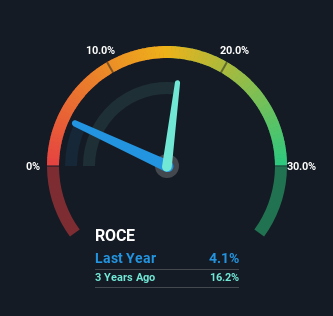- South Korea
- /
- Machinery
- /
- KOSDAQ:A045520
Clean & Science (KOSDAQ:045520) Is Finding It Tricky To Allocate Its Capital
Ignoring the stock price of a company, what are the underlying trends that tell us a business is past the growth phase? Typically, we'll see the trend of both return on capital employed (ROCE) declining and this usually coincides with a decreasing amount of capital employed. This reveals that the company isn't compounding shareholder wealth because returns are falling and its net asset base is shrinking. So after glancing at the trends within Clean & Science (KOSDAQ:045520), we weren't too hopeful.
What Is Return On Capital Employed (ROCE)?
For those who don't know, ROCE is a measure of a company's yearly pre-tax profit (its return), relative to the capital employed in the business. Analysts use this formula to calculate it for Clean & Science:
Return on Capital Employed = Earnings Before Interest and Tax (EBIT) ÷ (Total Assets - Current Liabilities)
0.041 = ₩2.2b ÷ (₩95b - ₩43b) (Based on the trailing twelve months to March 2024).
Therefore, Clean & Science has an ROCE of 4.1%. In absolute terms, that's a low return and it also under-performs the Machinery industry average of 6.5%.
See our latest analysis for Clean & Science

Historical performance is a great place to start when researching a stock so above you can see the gauge for Clean & Science's ROCE against it's prior returns. If you'd like to look at how Clean & Science has performed in the past in other metrics, you can view this free graph of Clean & Science's past earnings, revenue and cash flow.
How Are Returns Trending?
We are a bit worried about the trend of returns on capital at Clean & Science. To be more specific, the ROCE was 20% five years ago, but since then it has dropped noticeably. Meanwhile, capital employed in the business has stayed roughly the flat over the period. This combination can be indicative of a mature business that still has areas to deploy capital, but the returns received aren't as high due potentially to new competition or smaller margins. If these trends continue, we wouldn't expect Clean & Science to turn into a multi-bagger.
While on the subject, we noticed that the ratio of current liabilities to total assets has risen to 45%, which has impacted the ROCE. If current liabilities hadn't increased as much as they did, the ROCE could actually be even lower. And with current liabilities at these levels, suppliers or short-term creditors are effectively funding a large part of the business, which can introduce some risks.
Our Take On Clean & Science's ROCE
In summary, it's unfortunate that Clean & Science is generating lower returns from the same amount of capital. Long term shareholders who've owned the stock over the last five years have experienced a 70% depreciation in their investment, so it appears the market might not like these trends either. With underlying trends that aren't great in these areas, we'd consider looking elsewhere.
If you want to know some of the risks facing Clean & Science we've found 3 warning signs (2 can't be ignored!) that you should be aware of before investing here.
While Clean & Science may not currently earn the highest returns, we've compiled a list of companies that currently earn more than 25% return on equity. Check out this free list here.
New: AI Stock Screener & Alerts
Our new AI Stock Screener scans the market every day to uncover opportunities.
• Dividend Powerhouses (3%+ Yield)
• Undervalued Small Caps with Insider Buying
• High growth Tech and AI Companies
Or build your own from over 50 metrics.
Have feedback on this article? Concerned about the content? Get in touch with us directly. Alternatively, email editorial-team (at) simplywallst.com.
This article by Simply Wall St is general in nature. We provide commentary based on historical data and analyst forecasts only using an unbiased methodology and our articles are not intended to be financial advice. It does not constitute a recommendation to buy or sell any stock, and does not take account of your objectives, or your financial situation. We aim to bring you long-term focused analysis driven by fundamental data. Note that our analysis may not factor in the latest price-sensitive company announcements or qualitative material. Simply Wall St has no position in any stocks mentioned.
About KOSDAQ:A045520
Clean & Science
Manufactures and markets filtration media products in South Korea and internationally.
Low risk and slightly overvalued.
Market Insights
Community Narratives




